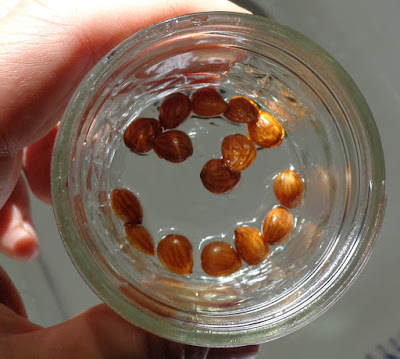 |
| Front Border. 7.16.15 |
 |
| Agapanthus. 7.26.15 |
 |
| Joe Pye Weed at about 4 months. 7.26.15 |
Random updates.
Front borders are getting close to where I want them. There are plenty of Spring blooming bulbs, foliage now dead and waiting for another turn of the year. They are the first wave.
For the second wave, there are lots of
Daylilies and
annuals. I know better what annuals will do well. The nasturtiums that have a big early display, then die, I will not save seeds from those. I will save seeds from the ones that bloom for another month or more. The
marigolds, heritage French type, have been excellent and continue to bloom like crazy.
Daylilies take the heat and just continue to bloom. The new daylily plants continue to grow, slowly. Now that there are plenty of seed pods, I am dead-heading some of the just-bloomed flowers to keep them looking neater.
When I took the overwintered, dried-out
Agapanthus out of the garage this Spring, it didn't look like much. So I planted nasturtiums in the container around the
Agapanthus. They had their burst of bloom, then burnt out. Now the Agapanthus is blooming generously.
Geraniums need dead heading. The 90s to 100 temp, and blazing sun, burns out the petals. The leaves look good.
The
borage died out, but now a second wave of volunteers is blooming, and a 3rd wave of seedlings has germinated.
The
Joe Pye Weed is settled in and growing robust leaves. At the top - there may be some early flower buds. That would be nice.
 |
| Four O'clocks, Nasturtiums, Geraniums. 7.26.15 |
 |
| Tigridia. 7.26.15 |
Tigridia continues to bloom. Even though each flower lasts one day, each stem has a succession of bloom. Planting them in a cluster, in container, works well.
Four O'clocks are blooming nicely too. The plants that survived the winter are larger and more robust than the new seedlings, but they all look good. The more I grow Four O'clocks, the more I like them. They don't mind a little shade, but they grow better in full sun. They do make a lot of volunteers, but those are easy to pull out if not wanted.
Sedums grew robust new mounds, with lots of flower buds. They will be the 3rd wave of flowers in the front borders. Bees really love sedum flowers, so that is an additional benefit.
Of all of the main flowers, borage is about the only one that really feeds the bees. I have bunches of oregano plants throughout. The bumblebees and honeybees also forage heavily on oregano flowers, in full bloom now.




























